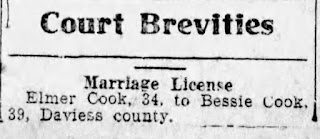Tumultuous Homelife Leads to Prison and a Grim Night on an Arizona Cliff
Thomas Joseph Cook: 1929-1957 (Maternal Third Cousin 2x Removed)
While researching Elmer Cook for my previous post, I
reviewed records for his children, including his son Thomas Joseph Cook. I discovered
that Thomas’ life was cut even shorter than his father’s and was equally
troubled, including a stint in an institution: a prison.
Thomas was born April 24, 1929 in McLean County, Kentucky, to
parents Elmer Cook and Lula Aldrige. Following his father’s murder in 1936 when
Thomas was seven, Thomas’ mother was unable to keep the children together. She separated
them and sent them to live with various relatives. Thomas’ sister Lottie May
was sent to live with Elmer’s cousin Otis and was eventually adopted by him and
his wife. The youngest child, Mary Alice, was adopted by a family named
Weatherford. Thomas was sent to live with Tennie Aldrige, his grandmother. He
appears in her Owensboro household in the 1940 census, although she has
reported him as her nephew rather than her grandson.
Thomas apparently moved to California at some point and
ended up in prison. The 1950 census finds him as an inmate at San Quentin, a state
prison near San Rafael, California. I have been unable to find any news articles
that explain his crime, and it is unclear how long he was institutionalized.
.jpg)
1950 Census for San Quentin Prison showing Thomas Cook of Kentucky as an inmate.
He ended up in Arizona after his release, working for a guano
mine on the rim of the Grand Canyon. U.S. Guano Corp. began mining bat guano
from a large cave above the canyon. Guano was used for fertilizer, and
erroneous estimates claimed there were hundreds of thousands of dollars of
guano in the cave. A tram was built across the Grand Canyon to transport the
guano, and miners were hired to dig and sweep up the guano from the cave. The
mine barely operated three or four years before closing down due to
unprofitability.
 |
| Historical Marker at U.S. Guano Corp. site. Photo courtesy Wikimedia Commons. |
In the wee hours of Christmas Eve 1957, Thomas somehow fell off
the cliff near the tram loading area. He plunged 125 feet, landing on a ledge
where fellow employees and sheriff’s department officers recovered his body.
The incident was reported in the local newspaper rather
matter-of-factly, but it must have been a little murkier than the article suggested.
The death certificate was not signed until January 3, ten days after Thomas’
death. The cause of death reads:
“Coroners Jury Verdict: Injuries sustained in an accidental
fall off of the cliff near the upper tower at the Bat-Chit U.S. Guano Cave.”
Further down on the certificate, it notes time of death was
12:10 a.m. (after midnight) and that the death occurred “not while at work”. Thomas’
job position was listed as “mechanic” so he wasn’t one of the miners actually
digging up the guano. Still, there would have been questions about why Thomas
was at the cliff edge long after the workday was over, enough questions that
the death was brought before a coroner’s jury to rule out foul play or even
suicide.
.jpg) |
| View of cliff edge by tram area, the approximate area Thomas fell from. Photo Wikimedia Commons. |
On a lighter note, I loved that the location of the death
was “Bat Chit”—probably a humorous nickname for the site of a cave full of bat
you-know-what. And Bat Chit Crazy sums up Thomas’ short and tragic life.
Following his death, his body was returned to Owensboro for
burial, and Thomas was buried in Brushy Fork Cemetery where his grandfather George
Edward “Ned” Cook is buried. Thomas’ obituary lists his mother’s address at the
time of his death as Kingman, Arizona, which was the town nearest the guano
mine. Perhaps he had been living with his mother after he was released from San
Quentin.
Sources:
Photo of Guano Point Mine Ruins, Grand Canyon, AZ. https://commons.wikimedia.org/wiki/File:Guano_Point,_Grand_Canyon,_AZ,_USA_(9536784300).jpg
“Grand Canyon Fall Fatal to Worker”. Arizona Daily Star,
Tucson, Arizona. Dec. 25, 1957.
Thomas Cook Death Certificate. Ancestry.com. Arizona, U.S.,
Death Records, 1887-1968 [database on-line]. Lehi, UT, USA: Ancestry.com
Operations, Inc., 2016.
“Former Owensboroan Killed in Fall in Arizona”. Owensboro
Messenger Inquirer. Owensboro, Kentucky. Jan. 8, 1958.










